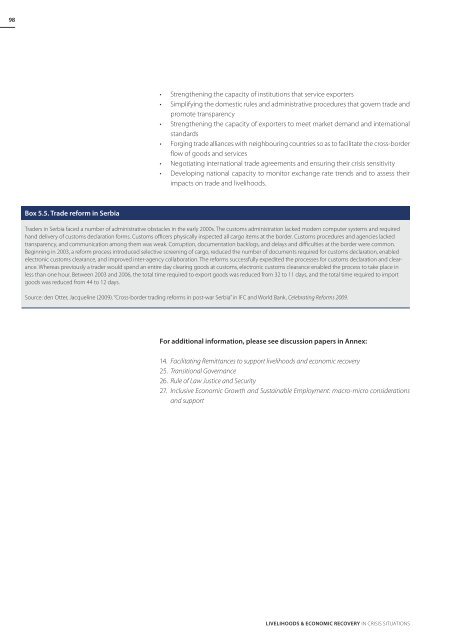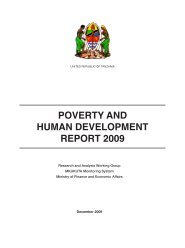Download PDF (4.08 MB) - ReliefWeb
Download PDF (4.08 MB) - ReliefWeb
Download PDF (4.08 MB) - ReliefWeb
You also want an ePaper? Increase the reach of your titles
YUMPU automatically turns print PDFs into web optimized ePapers that Google loves.
98<br />
• Strengthening the capacity of institutions that service exporters<br />
• Simplifying the domestic rules and administrative procedures that govern trade and<br />
promote transparency<br />
• Strengthening the capacity of exporters to meet market demand and international<br />
standards<br />
• Forging trade alliances with neighbouring countries so as to facilitate the cross-border<br />
flow of goods and services<br />
• Negotiating international trade agreements and ensuring their crisis sensitivity<br />
• Developing national capacity to monitor exchange rate trends and to assess their<br />
impacts on trade and livelihoods.<br />
Box 5.5. Trade reform in Serbia<br />
Traders in Serbia faced a number of administrative obstacles in the early 2000s. The customs administration lacked modern computer systems and required<br />
hand delivery of customs declaration forms. Customs officers physically inspected all cargo items at the border. Customs procedures and agencies lacked<br />
transparency, and communication among them was weak. Corruption, documentation backlogs, and delays and difficulties at the border were common.<br />
Beginning in 2003, a reform process introduced selective screening of cargo, reduced the number of documents required for customs declaration, enabled<br />
electronic customs clearance, and improved inter-agency collaboration. The reforms successfully expedited the processes for customs declaration and clearance.<br />
Whereas previously a trader would spend an entire day clearing goods at customs, electronic customs clearance enabled the process to take place in<br />
less than one hour. Between 2003 and 2006, the total time required to export goods was reduced from 32 to 11 days, and the total time required to import<br />
goods was reduced from 44 to 12 days.<br />
Source: den Otter, Jacqueline (2009). “Cross-border trading reforms in post-war Serbia” in IFC and World Bank, Celebrating Reforms 2009.<br />
For additional information, please see discussion papers in Annex:<br />
14. Facilitating Remittances to support livelihoods and economic recovery<br />
25. Transitional Governance<br />
26. Rule of Law Justice and Security<br />
27. Inclusive Economic Growth and Sustainable Employment: macro-micro considerations<br />
and support<br />
Livelihoods & Economic Recovery in Crisis Situations





